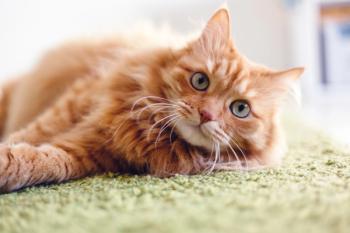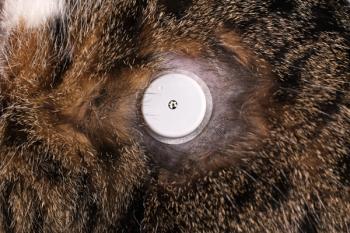
Life without lente or the glucose curve (Proceedings)
Cats are true carnivores and as such have a metabolism specifically adapted to high protein meals.
Objectives
• Discuss the etiology and progression of the diabetes in the cat
• Compare and contrast the new insulins on the market
• Discuss the pros and cons of the glucose curve, in-home monitoring and the use of fructosamine
Key Points
• The etiology of diabetes in cats is related to insulin resistance and glucose toxicity resulting in impairment of insulin secretion and beta cell destruction
• PZI is no longer available, but glargine has been promising in cats, especially newly diagnosed diabetics
• Dedicated owners may find home monitoring an attractive alternative when used in conjunction with monitoring of clinical signs and periodic fructosamine levels
Background
Cats are true carnivores and as such have a metabolism specifically adapted to high protein meals:
• Proteins (amino acids) provide the substrate for gluconeogenesis;
• Cats continue to produce glucose even during the fed state;
• Cats appear to be naturally "insulin resistant" as a means of maintaining euglycemia during long-periods of fasting that occur in the wild;
• Cats have limited function of glucokinase, hexokinase and glycogen synthetase which are enzymes used to convert glucose to the glycogen.
These metabolic strategies mean that they are less efficient at "sopping up" post-prandial glucose loads that occur with high carbohydrate meals. Commercial dry diets, by virtue of the processing that must occur to create a dry diet, contain higher quantities of carbohydrates than the comparable canned diet. In order to deal with the post-prandial hyperglycemia, the pancreas secretes ever increasing levels of insulin, for a time, to maintain euglycemia. Obesity can add to the insulin resistance and stimulate additional insulin secretion. There are several problems with this scenario of hyperglycemia and initial hyperinsulinemia. With increased insulin secretion, there is increased amylin secretion, a molecule that is co-secreted with insulin. Amylin is then deposited back into the islet cells as amyloid causing destruction over time of the beta cell leading eventually to decreased insulin secretion. Hyperglycemia causes "glucose toxicity" in which glucose receptors on the beta cell become "desensitized" from chronic stimulation, thus impairing insulin secretion from the beta cell, again ultimately leading to decreased insulin secretion and exacerbation of hyperglycemia. This unique metabolism makes the cat predisposed to Type II diabetes given the twin evils of obesity and high carbohydrate diets. With on-going destruction of the beta cells, Type I diabetes can eventually occur.
Insulins
Insulin species that are available are beef, pork and human recombinant. Feline insulin differs from human insulin by 4 amino acids, from pork by 3 amino acids and from beef by 1 amino acid. This is why beef/pork mixtures such as PZI have been preferred in the past. Fortunately, even though human and pork insulins are slightly different from feline insulin, anti-insulin antibodies are uncommon and account for less than 5% of cases of insulin resistance in diabetic cats. Types of insulins for use in cats include:
Lente
A crystalline insulin which owes its duration effect to the size of the crystal molecule (larger equals longer duration – regular insulin, for example, is a small crystalline molecule) Human-recombinant insulin products such and Humulin-L have gone off the market due to lack of demand since the advent of newer recombinant insulins. The current Lente veterinary product is pork source Lente (Vetsulin®, Caninsulin®) can be used in cats. Vetsulin is manufactured at a concentration of 40 U/ml and requires U-40 syringes. It is important to take care when switching to a U-100 insulin to avoid overdosing (if the owner does not also change to U-100 syringes). Lente should be dosed on a BID schedule.
NPH
Its duration effects are modulated by the addition of zinc and the fish protein protamine. NPH is generally more potent insulin than Lente, but can be used successfully in cats. The human-recombinant products (Novalin-N®, Humulin-N®) are still available. NPH is 100 U/ml and should be administered twice daily.
PZI
This beef/pork mixture is no longer being made, but the most recently manufactured batches do not expire until 2010 so veterinarians and owners have stockpiled these. Like Vetsulin, PZI is manufactured at a concentration of 40 U/ml and therefore requires U-40 syringes. Despite its longer-acting duration, it should be administered twice daily to start. In some cats, once daily dosing may be eventually achieved.
Insulin Glargine
Glargine is a human-recombinant insulin whose structure has been genetically modified. The modification changes the pH solubility of the molecule, so that it is soluble at a pH of 4 but insoluble at a neutral pH. When glargine is injected into the skin, it precipitates out into insoluble microcrystals which are slowly absorbed into the circulation. This characteristic gives glargine its duration effect and its relative lack of large peaks and troughs (however, this does not mean the glargine has no nadir). This mechanism of action is also the reason that glargine cannot be diluted. In humans, glargine is used as a "background" insulin to provide a stable level of insulin over a 24-hour period. Short-acting insulins, such as regular insulin, lispro or aspart (see below) are then added at mealtimes in humans to manage post-prandial hyperglycemia. In cats, recommendations for starting frequency differ but most experts agree that twice daily dosing provides better glycemic control. One group found that a greater number of newly-diagnosed diabetic cats went into remission (no longer required insulin) when started with glargine than with lente or PZI.
Lispro and Aspart
These are very rapidly-acting insulins that are akin to regular insulin used during meals. There are some anecdotal reports of their use in cats and dogs, but neither of these insulins has been studied in these species.
Detemir
A long-acting insulin used in much the same way as insulin glargine, i.e., as a baseline insulin. It is not a precipitate-forming insulin, deriving its duration effects by the addition of a fatty acid to the insulin molecule leading to increased binding to albumin. Again, there are no studies to date evaluating this insulin in diabetic cats.
Fructosamine vs Glycated Hemoglobin Measurements
Fructosamine is a glycated protein (mostly albumin) that can be used to monitor the history of hyperglycemia in the diabetic patient. The glycosylation occurs with states of hyperglycemia and is irreversible meaning that the fructosamine remains in circulation for the life of the protein, which in the case of albumin is approximately 1-3 weeks. Glycated hemoglobin remains in circulation for the life of the red blood cells which differs by species, ~70 days in cats, but because this assay is not readily available, fructosamine is the more commonly measured glycated protein. Fructosamine is also a reasonable alternative because the complications of diabetes (retinopathies, neuropathies, nephropathies, vasculopathies, etc) often take years to develop; therefore the same fine-tuned control needed in diabetic people is not as crucial in cats. However, this does not mean ignoring cats that are not well-controlled as we certainly see neuropathies with uncontrolled diabetics and one study of 54 diabetic cats reported that ~19% had renal insufficiency.
Glucose Curve
By far, the most important means of monitoring a patient's glycemic control is clinical signs! The cat should become less PU/PD and polyphagic and the weight loss should stabilize. Use of the glucose curve to evaluate the degree glycemic control and to identify potential causes of lack of glycemic control is well-established. However, glucose curves in cats are notoriously difficult because of stress hyperglycemia which can be as high as 350 mg/dl in some cases. Furthermore, cats may be reluctant to eat in the hospital environment making an accurate assessment of their glycemic control difficult to ascertain. Although having the owner feed the cat and administer the insulin at home is an option, it is ideal to evaluate the pre-meal/pre-insulin glucose level. This has led to an increasing number of owners generating glucose curves at home as a less stressful, and potentially more accurate, management tool. The latter has been questioned in a study of cats in which curves generated at home differed from those generated in-hospital. In that study, recommendations regarding dosage changes based on in-hospital curves would have differed 38% of the time from those based on glucose curves generated at home. Another study showed that there is also significant day-to-day variability even in those glucose curves generated at home. These disadvantages may be outweighed by convenience for the owner and better compliance with the management of the cat. What is most important about home monitoring is to ensure that owners are not making adjustments of insulin without consultation with the veterinarian. Secondly, the veterinarian should be compensated for the patient management and glucose curve interpretation even though the glucose curve is being generated at home.
References
Zoran DL. The carnivore connection to nutrition in cats. J Vet Med Assoc, 2002; 221(11): 1559-1560.
Brand Miller JC, Colagiuri S. The carnivore connection: dietary carbohydrate in the evolution of NIDDM. Diabetologica 1994;37:1280-1286.
Feldman EC, Nelson RW (eds). Feline Diabetes Mellitus. In Canine and Feline Endocrinology and Reproduction, 3rd ed. St Louis, MO: WB Saunders 2004;539-579.
Marshall RD, Rand JS. Treatment with insulin glargine results in higher remission rates than lente or protamine zinc insulins in newly diagnosed diabetic cats (abstract). J Vet Int Med 2005;19:425.
Casella M, Wess G, Hassig M, et al. Home monitoring of blood glucose concentration by owners of diabetic dogs. J Sm Anim Pract 2005;44:298-305.
Newsletter
From exam room tips to practice management insights, get trusted veterinary news delivered straight to your inbox—subscribe to dvm360.






